Analysis of LMX Theory and Transformational Leadership in Leadership
VerifiedAdded on 2022/11/28
|5
|1423
|80
Essay
AI Summary
This essay delves into the Leader-Member Exchange (LMX) theory and transformational leadership, examining their impact on personal leadership styles. The author reflects on their experience with questionnaires assessing LMX and transformational leadership, highlighting the importance of leader-subordinate relationships and the various dimensions of leadership behavior. The analysis includes scores from the LMX 7 questionnaire, indicating a strong understanding of subordinate needs, and insights from the Multifactor Leadership Questionnaire (MLQ) form 5X Short, revealing the author's alignment with transformational leadership principles. The essay emphasizes the significance of fostering a harmonious working environment, motivating subordinates, and using authority to solve problems. The author concludes by illustrating how these theories have enhanced their leadership qualities, inspiring them to prioritize team development and ethical decision-making.
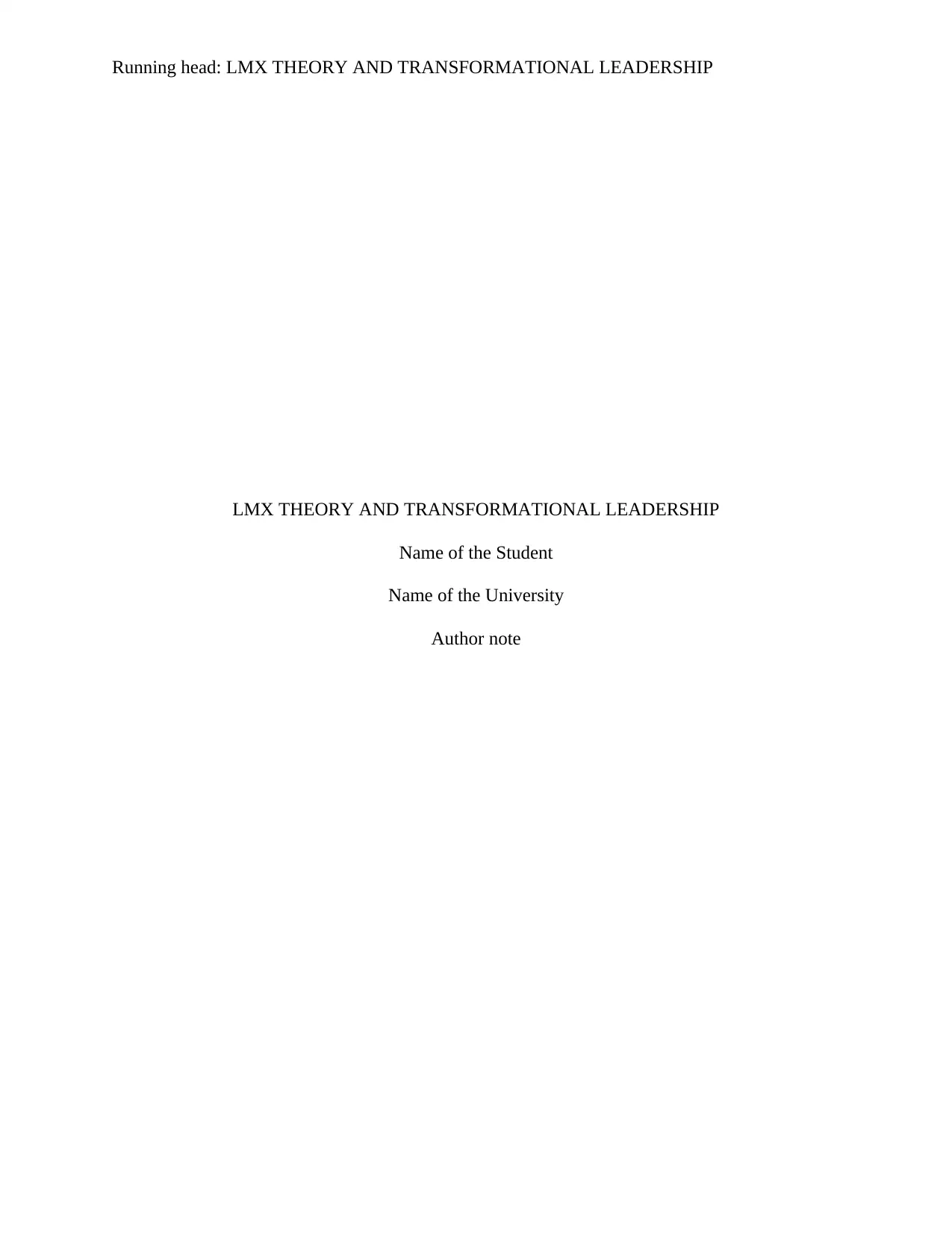
Running head: LMX THEORY AND TRANSFORMATIONAL LEADERSHIP
LMX THEORY AND TRANSFORMATIONAL LEADERSHIP
Name of the Student
Name of the University
Author note
LMX THEORY AND TRANSFORMATIONAL LEADERSHIP
Name of the Student
Name of the University
Author note
Paraphrase This Document
Need a fresh take? Get an instant paraphrase of this document with our AI Paraphraser
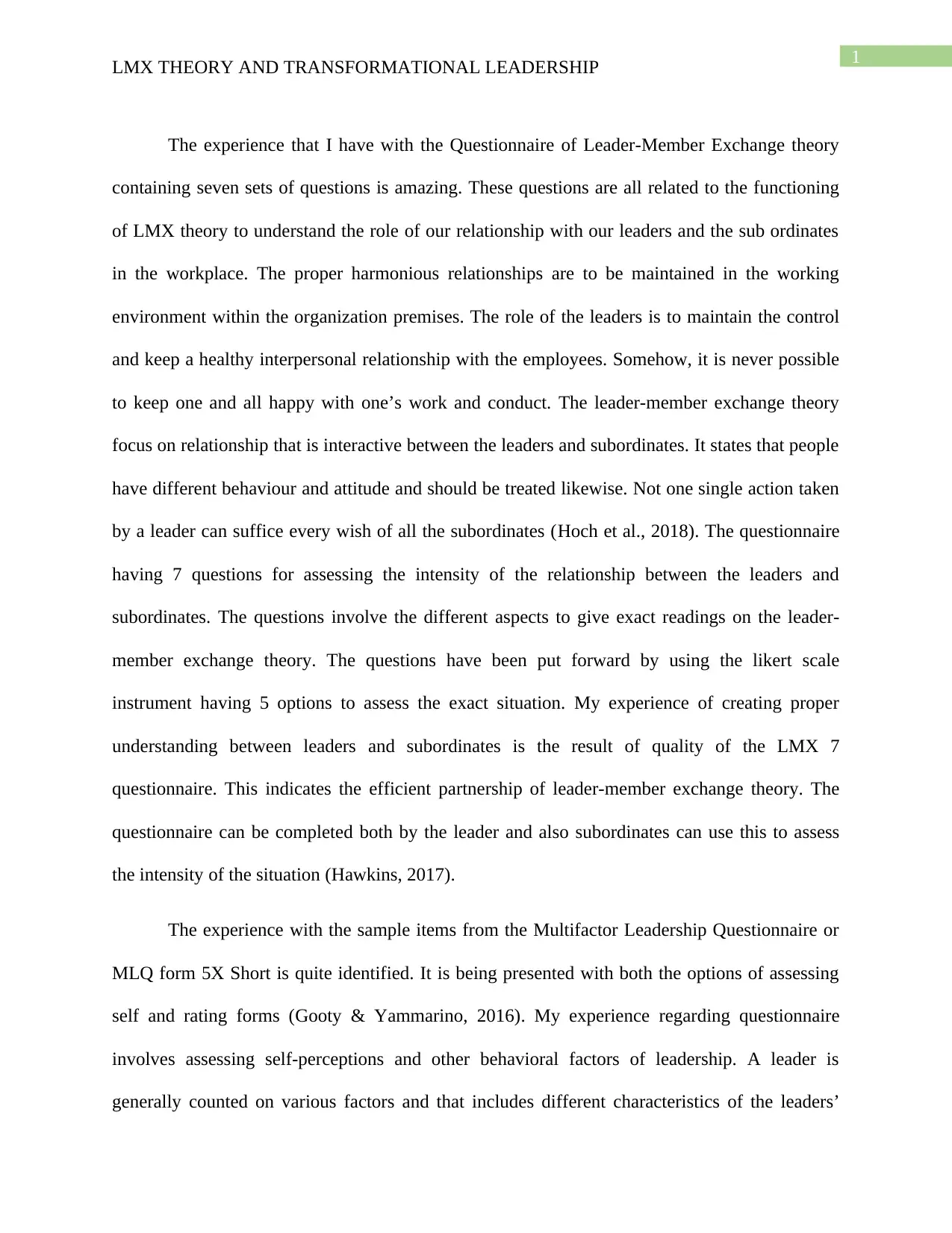
1
LMX THEORY AND TRANSFORMATIONAL LEADERSHIP
The experience that I have with the Questionnaire of Leader-Member Exchange theory
containing seven sets of questions is amazing. These questions are all related to the functioning
of LMX theory to understand the role of our relationship with our leaders and the sub ordinates
in the workplace. The proper harmonious relationships are to be maintained in the working
environment within the organization premises. The role of the leaders is to maintain the control
and keep a healthy interpersonal relationship with the employees. Somehow, it is never possible
to keep one and all happy with one’s work and conduct. The leader-member exchange theory
focus on relationship that is interactive between the leaders and subordinates. It states that people
have different behaviour and attitude and should be treated likewise. Not one single action taken
by a leader can suffice every wish of all the subordinates (Hoch et al., 2018). The questionnaire
having 7 questions for assessing the intensity of the relationship between the leaders and
subordinates. The questions involve the different aspects to give exact readings on the leader-
member exchange theory. The questions have been put forward by using the likert scale
instrument having 5 options to assess the exact situation. My experience of creating proper
understanding between leaders and subordinates is the result of quality of the LMX 7
questionnaire. This indicates the efficient partnership of leader-member exchange theory. The
questionnaire can be completed both by the leader and also subordinates can use this to assess
the intensity of the situation (Hawkins, 2017).
The experience with the sample items from the Multifactor Leadership Questionnaire or
MLQ form 5X Short is quite identified. It is being presented with both the options of assessing
self and rating forms (Gooty & Yammarino, 2016). My experience regarding questionnaire
involves assessing self-perceptions and other behavioral factors of leadership. A leader is
generally counted on various factors and that includes different characteristics of the leaders’
LMX THEORY AND TRANSFORMATIONAL LEADERSHIP
The experience that I have with the Questionnaire of Leader-Member Exchange theory
containing seven sets of questions is amazing. These questions are all related to the functioning
of LMX theory to understand the role of our relationship with our leaders and the sub ordinates
in the workplace. The proper harmonious relationships are to be maintained in the working
environment within the organization premises. The role of the leaders is to maintain the control
and keep a healthy interpersonal relationship with the employees. Somehow, it is never possible
to keep one and all happy with one’s work and conduct. The leader-member exchange theory
focus on relationship that is interactive between the leaders and subordinates. It states that people
have different behaviour and attitude and should be treated likewise. Not one single action taken
by a leader can suffice every wish of all the subordinates (Hoch et al., 2018). The questionnaire
having 7 questions for assessing the intensity of the relationship between the leaders and
subordinates. The questions involve the different aspects to give exact readings on the leader-
member exchange theory. The questions have been put forward by using the likert scale
instrument having 5 options to assess the exact situation. My experience of creating proper
understanding between leaders and subordinates is the result of quality of the LMX 7
questionnaire. This indicates the efficient partnership of leader-member exchange theory. The
questionnaire can be completed both by the leader and also subordinates can use this to assess
the intensity of the situation (Hawkins, 2017).
The experience with the sample items from the Multifactor Leadership Questionnaire or
MLQ form 5X Short is quite identified. It is being presented with both the options of assessing
self and rating forms (Gooty & Yammarino, 2016). My experience regarding questionnaire
involves assessing self-perceptions and other behavioral factors of leadership. A leader is
generally counted on various factors and that includes different characteristics of the leaders’
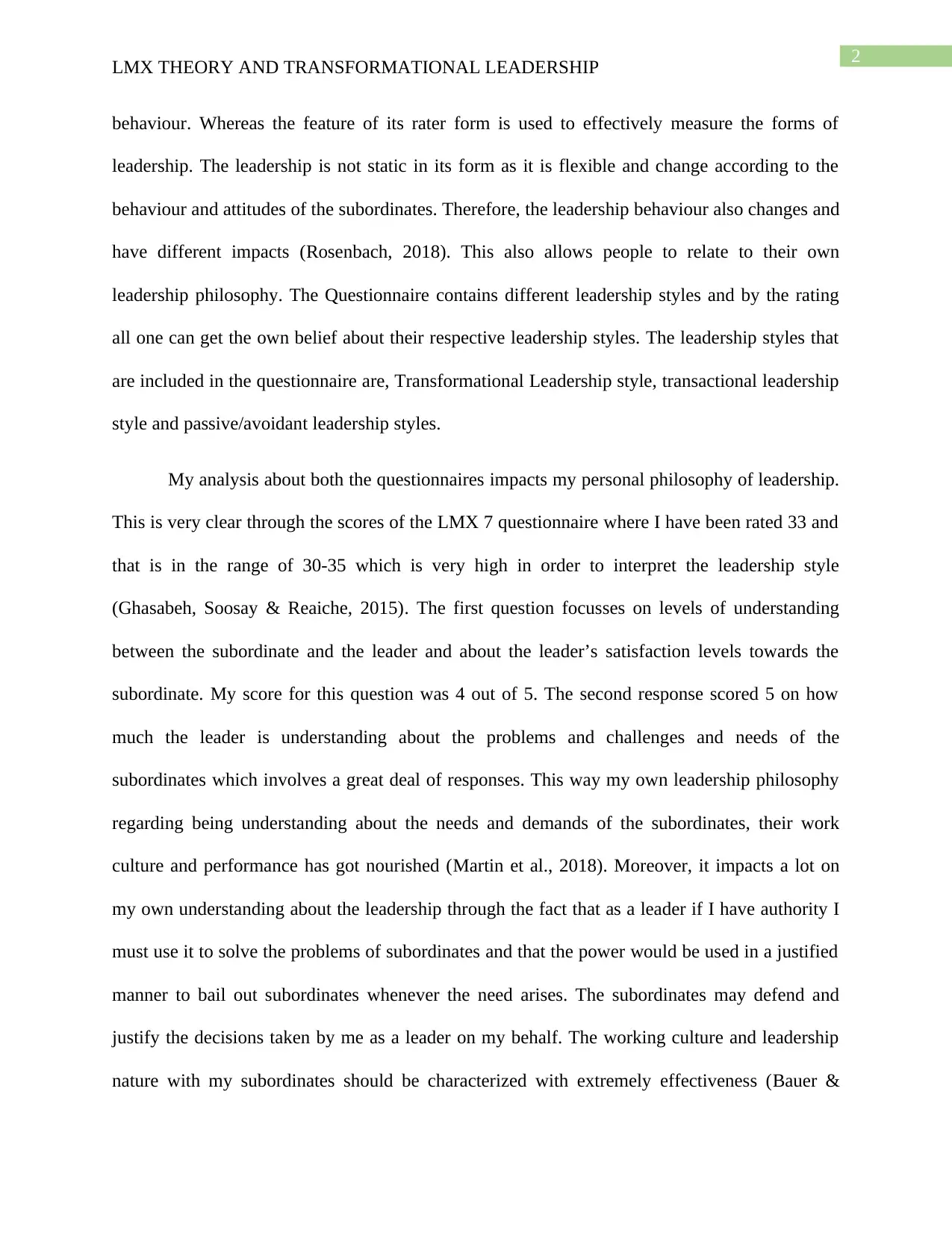
2
LMX THEORY AND TRANSFORMATIONAL LEADERSHIP
behaviour. Whereas the feature of its rater form is used to effectively measure the forms of
leadership. The leadership is not static in its form as it is flexible and change according to the
behaviour and attitudes of the subordinates. Therefore, the leadership behaviour also changes and
have different impacts (Rosenbach, 2018). This also allows people to relate to their own
leadership philosophy. The Questionnaire contains different leadership styles and by the rating
all one can get the own belief about their respective leadership styles. The leadership styles that
are included in the questionnaire are, Transformational Leadership style, transactional leadership
style and passive/avoidant leadership styles.
My analysis about both the questionnaires impacts my personal philosophy of leadership.
This is very clear through the scores of the LMX 7 questionnaire where I have been rated 33 and
that is in the range of 30-35 which is very high in order to interpret the leadership style
(Ghasabeh, Soosay & Reaiche, 2015). The first question focusses on levels of understanding
between the subordinate and the leader and about the leader’s satisfaction levels towards the
subordinate. My score for this question was 4 out of 5. The second response scored 5 on how
much the leader is understanding about the problems and challenges and needs of the
subordinates which involves a great deal of responses. This way my own leadership philosophy
regarding being understanding about the needs and demands of the subordinates, their work
culture and performance has got nourished (Martin et al., 2018). Moreover, it impacts a lot on
my own understanding about the leadership through the fact that as a leader if I have authority I
must use it to solve the problems of subordinates and that the power would be used in a justified
manner to bail out subordinates whenever the need arises. The subordinates may defend and
justify the decisions taken by me as a leader on my behalf. The working culture and leadership
nature with my subordinates should be characterized with extremely effectiveness (Bauer &
LMX THEORY AND TRANSFORMATIONAL LEADERSHIP
behaviour. Whereas the feature of its rater form is used to effectively measure the forms of
leadership. The leadership is not static in its form as it is flexible and change according to the
behaviour and attitudes of the subordinates. Therefore, the leadership behaviour also changes and
have different impacts (Rosenbach, 2018). This also allows people to relate to their own
leadership philosophy. The Questionnaire contains different leadership styles and by the rating
all one can get the own belief about their respective leadership styles. The leadership styles that
are included in the questionnaire are, Transformational Leadership style, transactional leadership
style and passive/avoidant leadership styles.
My analysis about both the questionnaires impacts my personal philosophy of leadership.
This is very clear through the scores of the LMX 7 questionnaire where I have been rated 33 and
that is in the range of 30-35 which is very high in order to interpret the leadership style
(Ghasabeh, Soosay & Reaiche, 2015). The first question focusses on levels of understanding
between the subordinate and the leader and about the leader’s satisfaction levels towards the
subordinate. My score for this question was 4 out of 5. The second response scored 5 on how
much the leader is understanding about the problems and challenges and needs of the
subordinates which involves a great deal of responses. This way my own leadership philosophy
regarding being understanding about the needs and demands of the subordinates, their work
culture and performance has got nourished (Martin et al., 2018). Moreover, it impacts a lot on
my own understanding about the leadership through the fact that as a leader if I have authority I
must use it to solve the problems of subordinates and that the power would be used in a justified
manner to bail out subordinates whenever the need arises. The subordinates may defend and
justify the decisions taken by me as a leader on my behalf. The working culture and leadership
nature with my subordinates should be characterized with extremely effectiveness (Bauer &
⊘ This is a preview!⊘
Do you want full access?
Subscribe today to unlock all pages.

Trusted by 1+ million students worldwide
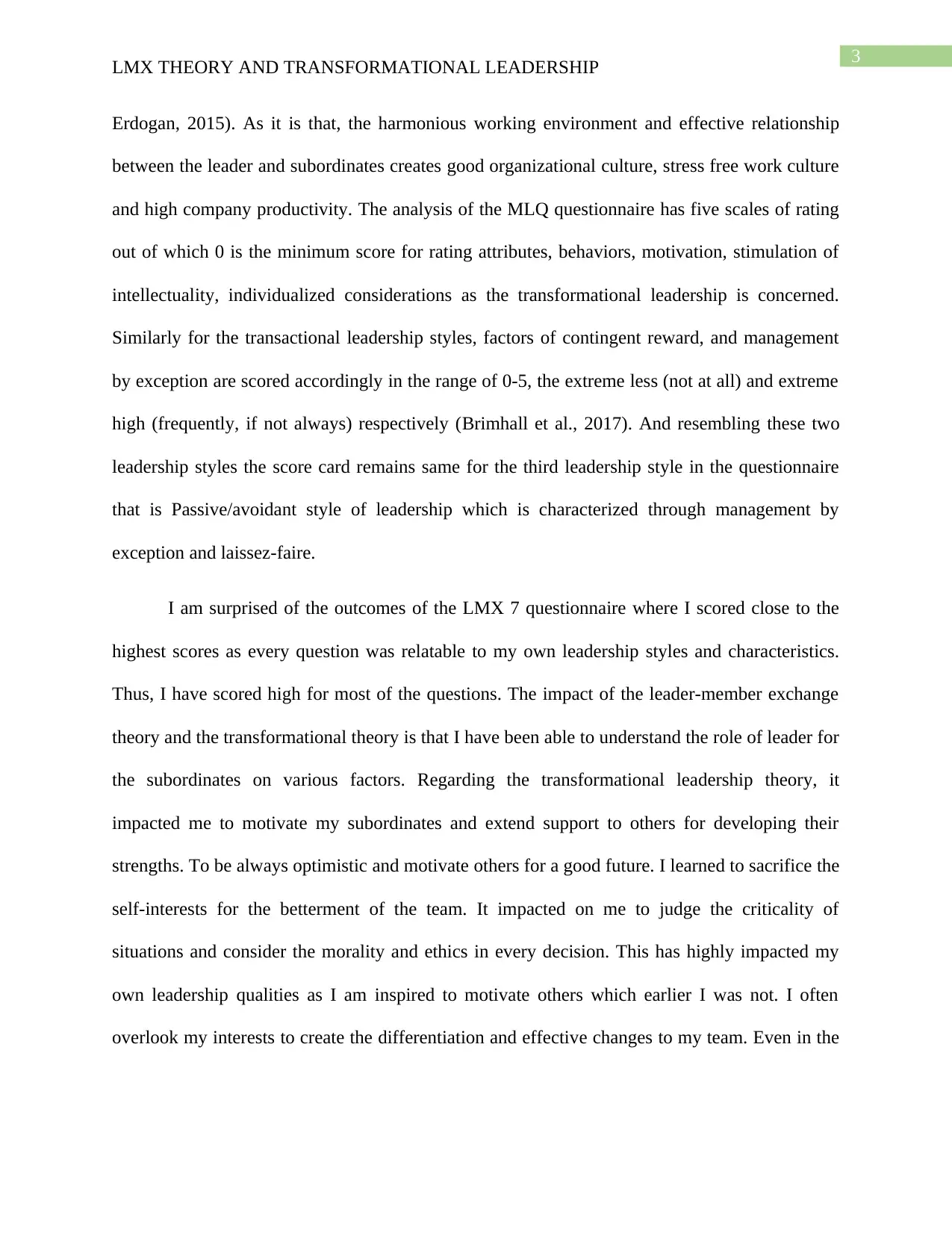
3
LMX THEORY AND TRANSFORMATIONAL LEADERSHIP
Erdogan, 2015). As it is that, the harmonious working environment and effective relationship
between the leader and subordinates creates good organizational culture, stress free work culture
and high company productivity. The analysis of the MLQ questionnaire has five scales of rating
out of which 0 is the minimum score for rating attributes, behaviors, motivation, stimulation of
intellectuality, individualized considerations as the transformational leadership is concerned.
Similarly for the transactional leadership styles, factors of contingent reward, and management
by exception are scored accordingly in the range of 0-5, the extreme less (not at all) and extreme
high (frequently, if not always) respectively (Brimhall et al., 2017). And resembling these two
leadership styles the score card remains same for the third leadership style in the questionnaire
that is Passive/avoidant style of leadership which is characterized through management by
exception and laissez-faire.
I am surprised of the outcomes of the LMX 7 questionnaire where I scored close to the
highest scores as every question was relatable to my own leadership styles and characteristics.
Thus, I have scored high for most of the questions. The impact of the leader-member exchange
theory and the transformational theory is that I have been able to understand the role of leader for
the subordinates on various factors. Regarding the transformational leadership theory, it
impacted me to motivate my subordinates and extend support to others for developing their
strengths. To be always optimistic and motivate others for a good future. I learned to sacrifice the
self-interests for the betterment of the team. It impacted on me to judge the criticality of
situations and consider the morality and ethics in every decision. This has highly impacted my
own leadership qualities as I am inspired to motivate others which earlier I was not. I often
overlook my interests to create the differentiation and effective changes to my team. Even in the
LMX THEORY AND TRANSFORMATIONAL LEADERSHIP
Erdogan, 2015). As it is that, the harmonious working environment and effective relationship
between the leader and subordinates creates good organizational culture, stress free work culture
and high company productivity. The analysis of the MLQ questionnaire has five scales of rating
out of which 0 is the minimum score for rating attributes, behaviors, motivation, stimulation of
intellectuality, individualized considerations as the transformational leadership is concerned.
Similarly for the transactional leadership styles, factors of contingent reward, and management
by exception are scored accordingly in the range of 0-5, the extreme less (not at all) and extreme
high (frequently, if not always) respectively (Brimhall et al., 2017). And resembling these two
leadership styles the score card remains same for the third leadership style in the questionnaire
that is Passive/avoidant style of leadership which is characterized through management by
exception and laissez-faire.
I am surprised of the outcomes of the LMX 7 questionnaire where I scored close to the
highest scores as every question was relatable to my own leadership styles and characteristics.
Thus, I have scored high for most of the questions. The impact of the leader-member exchange
theory and the transformational theory is that I have been able to understand the role of leader for
the subordinates on various factors. Regarding the transformational leadership theory, it
impacted me to motivate my subordinates and extend support to others for developing their
strengths. To be always optimistic and motivate others for a good future. I learned to sacrifice the
self-interests for the betterment of the team. It impacted on me to judge the criticality of
situations and consider the morality and ethics in every decision. This has highly impacted my
own leadership qualities as I am inspired to motivate others which earlier I was not. I often
overlook my interests to create the differentiation and effective changes to my team. Even in the
Paraphrase This Document
Need a fresh take? Get an instant paraphrase of this document with our AI Paraphraser
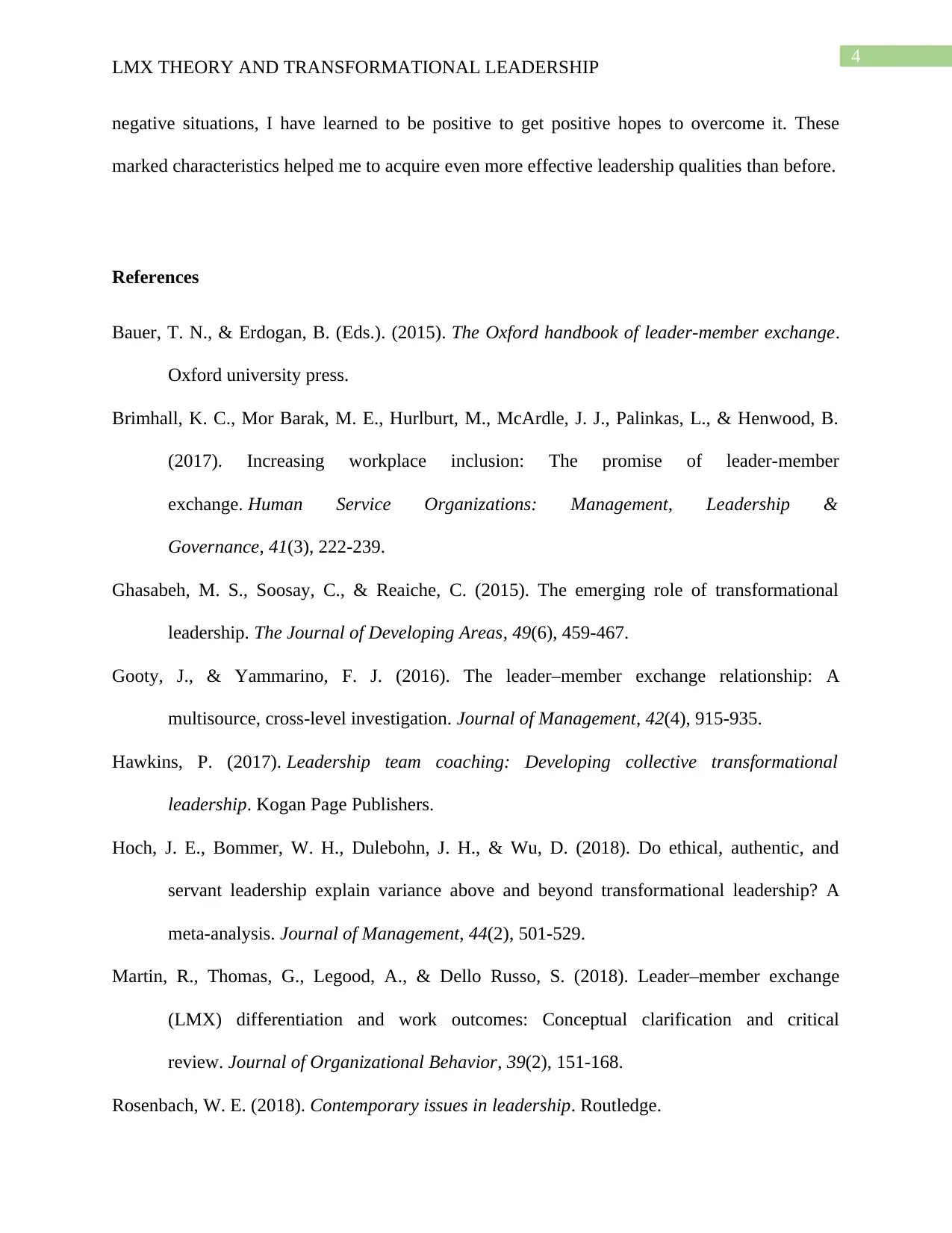
4
LMX THEORY AND TRANSFORMATIONAL LEADERSHIP
negative situations, I have learned to be positive to get positive hopes to overcome it. These
marked characteristics helped me to acquire even more effective leadership qualities than before.
References
Bauer, T. N., & Erdogan, B. (Eds.). (2015). The Oxford handbook of leader-member exchange.
Oxford university press.
Brimhall, K. C., Mor Barak, M. E., Hurlburt, M., McArdle, J. J., Palinkas, L., & Henwood, B.
(2017). Increasing workplace inclusion: The promise of leader-member
exchange. Human Service Organizations: Management, Leadership &
Governance, 41(3), 222-239.
Ghasabeh, M. S., Soosay, C., & Reaiche, C. (2015). The emerging role of transformational
leadership. The Journal of Developing Areas, 49(6), 459-467.
Gooty, J., & Yammarino, F. J. (2016). The leader–member exchange relationship: A
multisource, cross-level investigation. Journal of Management, 42(4), 915-935.
Hawkins, P. (2017). Leadership team coaching: Developing collective transformational
leadership. Kogan Page Publishers.
Hoch, J. E., Bommer, W. H., Dulebohn, J. H., & Wu, D. (2018). Do ethical, authentic, and
servant leadership explain variance above and beyond transformational leadership? A
meta-analysis. Journal of Management, 44(2), 501-529.
Martin, R., Thomas, G., Legood, A., & Dello Russo, S. (2018). Leader–member exchange
(LMX) differentiation and work outcomes: Conceptual clarification and critical
review. Journal of Organizational Behavior, 39(2), 151-168.
Rosenbach, W. E. (2018). Contemporary issues in leadership. Routledge.
LMX THEORY AND TRANSFORMATIONAL LEADERSHIP
negative situations, I have learned to be positive to get positive hopes to overcome it. These
marked characteristics helped me to acquire even more effective leadership qualities than before.
References
Bauer, T. N., & Erdogan, B. (Eds.). (2015). The Oxford handbook of leader-member exchange.
Oxford university press.
Brimhall, K. C., Mor Barak, M. E., Hurlburt, M., McArdle, J. J., Palinkas, L., & Henwood, B.
(2017). Increasing workplace inclusion: The promise of leader-member
exchange. Human Service Organizations: Management, Leadership &
Governance, 41(3), 222-239.
Ghasabeh, M. S., Soosay, C., & Reaiche, C. (2015). The emerging role of transformational
leadership. The Journal of Developing Areas, 49(6), 459-467.
Gooty, J., & Yammarino, F. J. (2016). The leader–member exchange relationship: A
multisource, cross-level investigation. Journal of Management, 42(4), 915-935.
Hawkins, P. (2017). Leadership team coaching: Developing collective transformational
leadership. Kogan Page Publishers.
Hoch, J. E., Bommer, W. H., Dulebohn, J. H., & Wu, D. (2018). Do ethical, authentic, and
servant leadership explain variance above and beyond transformational leadership? A
meta-analysis. Journal of Management, 44(2), 501-529.
Martin, R., Thomas, G., Legood, A., & Dello Russo, S. (2018). Leader–member exchange
(LMX) differentiation and work outcomes: Conceptual clarification and critical
review. Journal of Organizational Behavior, 39(2), 151-168.
Rosenbach, W. E. (2018). Contemporary issues in leadership. Routledge.
1 out of 5
Related Documents
Your All-in-One AI-Powered Toolkit for Academic Success.
+13062052269
info@desklib.com
Available 24*7 on WhatsApp / Email
![[object Object]](/_next/static/media/star-bottom.7253800d.svg)
Unlock your academic potential
Copyright © 2020–2025 A2Z Services. All Rights Reserved. Developed and managed by ZUCOL.





